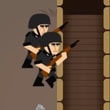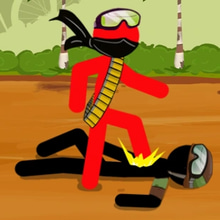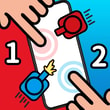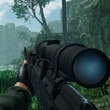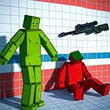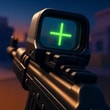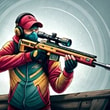🗺️ A Line in the Dust, A Plan in Your Head
The first thing Stickman Army Team Battle teaches you is that courage without a plan is just a mess in a different shape. You drop into the field with a thin budget, a handful of gritty soldiers, and a horizon that keeps coughing up enemy silhouettes. The map looks simple until it moves. Lanes churn, cover relocates, and waving flags mark pressure points that demand attention right now. You learn to see the battlefield as a living puzzle: where a shield-bearer buys breath, where a rifleman writes sentences in the air, where a grenadier can erase a mistake you swore you wouldn’t make again. The goal isn’t “more” or “bigger.” It’s cleaner lines, smarter trades, and the quiet satisfaction of watching chaos fold because you asked it politely, and then firmly, to do so.
🎖️ Soldiers With Jobs Not Titles
Every unit here has a purpose, and the game punishes you gently when you pretend otherwise. Shields belong on the beat where pressure peaks, their stance absorbing damage that would have flattened your entire left lane. Riflemen don’t just shoot; they set tempo, snipping at advancing clusters so your melee can arrive on time. Shotgunners thrive in short lanes where buildings funnel enemies into a cone shaped like consequence. Snipers wait, then make that wait matter with a single line that erases a captain and opens a door. Medics are math, converting a lost push into a shaky victory by stitching timing back together. The beauty is how these roles braid. A shield takes heat, a medic keeps him honest, a grenadier removes the second wave, and suddenly the lane that was crumbling is whistling a tune you like.
🔥 Momentum Is a Currency You Print With Nerve
Resources trickle. Choices don’t. You’ll stare at the meter and feel the itch to place something cheap now versus something perfect in ten seconds. That gap is where players become captains. Sometimes you flood the board with low-cost grunts to steal ground, then cash that space in for a heavy hitter. Sometimes you hold, hold, hold, then drop a combo that looks like a magic trick: a smoke to blind archers, a shield to soak the reply, a flanking melee to fold the line, and a sniper punctuation just to make the lesson stick. You start to hear momentum as a sound—the way gunfire changes pitch when your push is real, the way enemy footsteps stutter when a grenade lands exactly where a confidence problem should live.
🧠 Micro Reads, Macro Wins
Victories here are made of small, almost disrespectful decisions. A single tile to the left steals archer line-of-sight and saves three hit points that become a tower held. A half-second delay on deploying your shotgunner means their charge walks into a cone instead of around it. You’ll catch yourself breathing with the spawn timer, waiting for the beat that turns an even trade into a snowball. And when you miss, the game explains why without insulting you. The post-skirmish summary shows overcommit on right lane, underheal on center, wasted sniper shot into shield—that sort of tough love that feels like a conversation with a coach who wants you on the podium next week.
🏰 Missions That Escalate Like a Good Story
Early chapters are infantry chess. Capture ground, learn counters, get punished for laziness. Midgame adds armor, artillery, and captains with a sense of humor. A convoy scenario demands discipline: guards out front, soft targets tucked safe, your attention ping-ponging between a minefield and a sudden pincer. Night ops turn vision into a resource, with muzzle flashes painting maps and your brain whispering wait for the flare before committing. Boss encounters aren’t just chunky health bars—they’re choreography. That towering enemy banshee doesn’t fall to brute force; it falls to rhythm: bait the shockwave with a shield, step your line forward under smoke, drop a sticky on the exposed core, pull back before the retaliatory volley. Rinse? Not really. Repeat? Only if the terrain agrees. The fight writes itself differently because the ground keeps offering new verbs.
⚙️ Upgrades You Can Feel in Your Fingers
Progress isn’t a bland graph. It’s tactile. A faster reload on riflemen turns a teetering defense into a calm heartbeat. An extra plate on a shield converts desperation into patience. Sniper optics mean fewer whiffs on captains, which means fewer panic grenades, which means more budget for a proper flank. Utility tech matters, too. Cheaper respawn on medics makes attrition sustainable. A modest income perk snowballs into real map control. You’ll find a favorite build and then betray it when a mission says try again, but smarter. The best part is that upgrades don’t invalidate fundamentals. Bad positioning plus shiny toys is still bad. Good positioning plus small perks feels like magic you earned.
🎮 Controls That Respect Your War Room Brain
On desktop, placement is quick and precise, drag paths snap just enough to save your wrist, and hotkeys map to the way your brain groups roles. On mobile, your thumb gets honored instead of tested; the UI anticipates which lane you mean and highlights legal tiles without nagging. The camera glides, not yanks. You’ll zoom once for a captain snipe and glide back to the whole front without losing the thread. It’s a quiet interface, which is exactly what you need when five things go wrong and you decide to fix the sixth first because that’s secretly the one that fixes two, three, and four by itself.
🩸 The Cost of Mistakes and the Pleasure of Fixing Them
You will overextend. You will stack two expensive units into a counter they were born to fear and watch them evaporate like a lesson. The game doesn’t throw you off the horse for that. It gives you the reins back and a new wave with a slightly worse angle. Now you rebuild. Now you stop punching and start placing. It’s strangely intimate, the way a battered frontline can become a wall again because you believed it could and spent your next three calls on repair instead of revenge. When the tide turns, you’ll feel it physically—breath out, shoulders down, cursor lighter. Then you’ll make a note not to do the dumb thing again. You will do the dumb thing again. You will also recover faster next time.
🌐 Endless Skirmishes and Quiet Brags
While the campaign carries your hand through smarter and meaner problems, quick modes let you rehearse ideas without stakes. Try a low-eco rush, a double-medic sustain, a sniper anchor build that punishes overreach. Watch how the AI answers. Adjust. Stack small experiments until your style shows up: a measured, boringly efficient commander who never bleeds more than necessary, or a swaggering risk-lover who treats grenades like punctuation and still somehow lands the period exactly where it belongs. Leaderboards are there for the brag in your chest, but the real leaderboard is the way your map looks calmer round by round.
🏆 Why This Battlefield Sticks to Your Hands
Because every minute delivers a decision that matters. Because “use wisely the strengths of each soldier” isn’t a slogan here—it’s the only way anything works. Because learning counters feels less like memorizing a chart and more like learning a song you can hum under fire. Because a perfect hold with one shield, one medic, one rifleman, and one well-timed explosive is a miracle you built from cheap parts and good judgment. And because the moment you finally thread a flank through a cramped alley, neutralize the captain, and watch the enemy wave fold like a tired tent, you sit back and think I earned that smile. Then you queue the next mission and do it all again, a little cleaner, a little braver, with a plan you’ll change the second the ground surprises you. 💥🛡️🎯
 Playground Man!
Playground Man!




